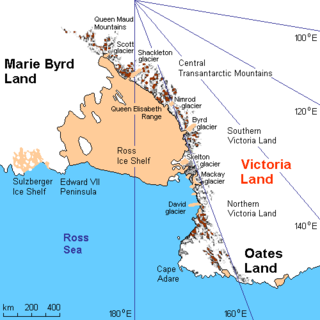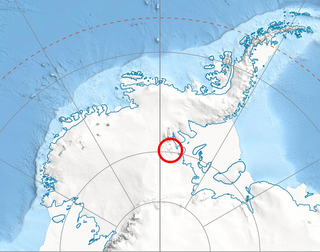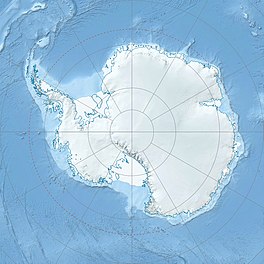The Marsh Glacier is a glacier about 110 km (70 mi) long, flowing north from the Antarctic polar plateau between the Miller Range and Queen Elizabeth Range into Nimrod Glacier. Seen by a New Zealand party of the CTAE (1956–58) and named for G.W. Marsh, a member of the party.

Skelton Glacier is a large glacier flowing from the polar plateau into the Ross Ice Shelf at Skelton Inlet on the Hillary Coast, south of Victoria Land, Antarctica.

The Wordie Ice Shelf was a confluent glacier projecting as an ice shelf into the SE part of Marguerite Bay between Cape Berteaux and Mount Edgell, along the western coast of Antarctic Peninsula.

Polar Times Glacier is a glacier on Ingrid Christensen Coast, flowing northward between Svarthausen Nunatak and Boyd Nunatak into the western part of Publications Ice Shelf. It was delineated by John H. Roscoe from aerial photographs taken by USN Operation Highjump, 1946–1947, and named by Roscoe after The Polar Times, a polar journal published by the American Polar Society, New York City.
Ketchum Glacier is an eastward flowing glacier at the base of Palmer Land, Antarctica, about 50 nautical miles (90 km) long, descending between the Latady Mountains and the Scaife Mountains into Gardner Inlet. It was discovered by the Ronne Antarctic Research Expedition (RARE), 1947–48, under Finn Ronne, who named it for Commander Gerald Ketchum, U.S. Navy, commander of the icebreaker USS Burton Island (AG-88) which broke the ice to free the RARE from Marguerite Bay for the return home.

Il Polo Glacier is a small glacier draining northward between Polar Times Glacier and Polarforschung Glacier into the Publications Ice Shelf, Antarctica. It was delineated in 1952 by John H. Roscoe from air photos taken by U.S. Navy Operation Highjump, 1946–47, and was named by Roscoe for Il Polo, a polar journal published by the Istituto Geografico, Forlì, Italy.
The Institute Ice Stream is an ice stream flowing north into the Ronne Ice Shelf, Antarctica, southeast of Hercules Inlet. The feature was traversed by the United States Antarctic Research Program (USARP) Ellsworth–Byrd Seismic Party, 1958–59, and the USARP – University of Wisconsin Seismic Party, 1963–64. It was delineated by the Scott Polar Research Institute – National Science Foundation – Technical University of Denmark airborne radio echo sounding program, 1967–79, and in association with Foundation Ice Stream and Support Force Glacier, named after the Scott Polar Research Institute, Cambridge, England.
Publications Ice Shelf is an Antarctic ice shelf about 35 nautical miles (60 km) long on the south shore of Prydz Bay, between Mount Caroline Mikkelsen and Stornes Peninsula. Several glaciers, listed from southwest to northeast, nourish the ice shelf: Polar Times Glacier, Il Polo Glacier, Polarforschung Glacier, Polar Record Glacier and Polararboken Glacier. The feature was first mapped from air photos by the Lars Christensen Expedition, 1936–37. The name "Publication Glacier Tongues" was applied by John H. Roscoe in 1952 following his study of U.S. Navy Operation Highjump (1946–47) air photos of the area, but the term ice shelf is more descriptive. So named by Roscoe because the several glaciers in the area commemorate polar publications.
Newall Glacier is a glacier in the east part of the Asgard Range of Victoria Land, flowing east between Mount Newall and Mount Weyant into the Wilson Piedmont Glacier. In its uppermost névé area sits Kaminuma Crag, a craggy, island-like nunatak, 0.75 nautical miles (1.4 km) long, rising to 1,750 metres (5,740 ft) high.
The Land Glacier is a broad, heavily crevassed glacier, about 35 nautical miles (60 km) long, descending into Land Bay in Marie Byrd Land, Antarctica. It was discovered by the U.S. Antarctic Service (1939–41) and named for Rear Admiral Emory S. Land, Chairman of the U.S. Maritime Commission.

Union Glacier, is a large, heavily crevassed glacier which receives the flow of several tributaries and drains through the middle of the Heritage Range, Ellsworth Mountains, Antarctica. The glacier drains from the plateau at Edson Hills on the west side of the range and flows east between Pioneer Heights and Enterprise Hills. Union Glacier was mapped by U.S. Geological Survey (USGS) from surveys and U.S. Navy (USN) air photos, 1961–66. The name was applied by Advisory Committee on Antarctic Names (US-ACAN) in association with the name Heritage Range.

Posadowsky Glacier is a glacier about 9 nautical miles long, flowing north to Posadowsky Bay immediately east of Gaussberg. Posadowsky Bay is an open embayment, located just east of the West Ice Shelf and fronting on the Davis Sea in Kaiser Wilhelm II Land. Kaiser Wilhelm II Land is the part of East Antarctica lying between Cape Penck, at 87°43'E, and Cape Filchner, at 91°54'E, and is claimed by Australia as part of the Australian Antarctic Territory. Other notable geographic features in this area include Drygalski Island, located 45 mi NNE of Cape Filchner in the Davis Sea, and Mirny Station, a Russian scientific research station.
Anthony Glacier is a glacier which flows in an east-southeast direction to the east coast of Palmer Land where it terminates opposite the south tip of Hearst Island. The upper part of this glacier was seen by a sledge party of the British Graham Land Expedition under John Riddoch Rymill in 1936–37. The glacier was seen from the seaward side in 1940 by a sledging party from the East Base of the United States Antarctic Service, and in 1947 was photographed from the air by the Ronne Antarctic Research Expedition (RARE). It was named by Finn Ronne for Alexander Anthony of the J.P. Stevens Company, New York City, which contributed windproof clothing to the RARE.
Sullivan Glacier is a glacier flowing west into Gilbert Glacier, immediately south of Elgar Uplands in the north part of Alexander Island, Antarctica. The glacier was first sighted from a distance by the British Graham Land Expedition during a flight in 1937 and roughly mapped. Remapped from air photos taken by the Ronne Antarctic Research Expedition in 1947–48, by Searle of the Falkland Islands Dependencies Survey in 1960. In association with the names of other composers in this area, named by United Kingdom Antarctic Place-Names Committee after Sir Arthur Sullivan (1842–1900), English composer.

Polarårboken Glacier is a glacier, 3 nautical miles (5.6 km) northeast of Stein Islands, draining westward into the north part of Publications Ice Shelf. Delineated in 1952 by John H. Roscoe from air photos taken by U.S. Navy Operation Highjump (1946–47). Named by Roscoe after Polarårboken, a polar journal published by the Norsk Polarklubb, Oslo, Norway.

Polarforschung Glacier is a heavily crevassed glacier flowing northward along the west side of Meknattane Nunataks to Publications Ice Shelf. Vestknatten Nunatak lies within the mouth of the glacier. Delineated in 1952 by John H. Roscoe from aerial photographs taken by U.S. Navy Operation Highjump (1946–47), and named by him after the journal Polarforschung, issued in Kiel.

Hargreaves Glacier is a glacier 2 nautical miles (4 km) west of Mount Caroline Mikkelsen on the Ingrid Christensen Coast of Antarctica. It drains into the central part of the head of Sandefjord Ice Bay. The glacier was delineated in 1952 by John H. Roscoe from aerial photographs taken by U.S. Navy Operation Highjump, 1946–47, and was named by him for R.B. Hargreaves, an aerial photographer on Operation Highjump flights in the area.
Matthews Glacier is a glacier on the east side of the Wilkins Mountains, Antarctica, draining south to enter the Ronne Ice Shelf just west of Dodson Peninsula. It was mapped by the United States Geological Survey from surveys and U.S. Navy air photos, 1961–67, and was named by the Advisory Committee on Antarctic Names for J.D. Matthews, an engineman at South Pole Station in 1963.
Tomilin Glacier is a glacier over 15 nautical miles (28 km) long, draining north from Pope Mountain in central Wilson Hills. It enters the sea east of Goodman Hills and Cape Kinsey, forming a substantial glacier tongue. The glacier was photographed from aircraft of U.S. Navy Operation Highjump in 1947, and by the Soviet Antarctic Expedition in 1958. Named by the latter for Soviet polar aviator Mikhail N. Tomilin (1908–52), who perished in the Arctic.






